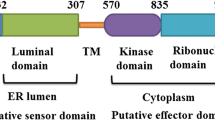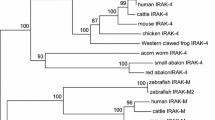Abstract
Myeloid differentiation factor 88 (MyD88) is a universal adaptor protein able to activate nuclear factor-kappa B (NF-κB) through interactions with interleukin-1 receptor (IL-1R) and the Toll-like receptors (TLRs), with the exception of TLR3. Here, we describe the identification of MyD88 from the rock bream fish Oplegnathus fasciatus and its characterization based on GS-FLX™ sequencing. The cDNA of rock bream MyD88 was found to be composed of 1626 bp, with an 867 bp open reading frame that encodes 288 amino acids. The deduced amino acid sequence of MyD88 possessed both a conserved death domain at the amino terminus and a typical Toll-IL-1 receptor (TIR) domain at the carboxyl terminus, similar to that found in other fishes, amphibians, avians, mammals and invertebrates. The mRNA expression pattern of MyD88 in healthy and bacterially challenged rock bream were examined using quantitative real-time polymerase chain reaction (qRT-PCR). MyD88 transcripts were found to be strongly expressed in blood, gill, liver, spleen, head kidney and kidney, moderately expressed in skin, brain and intestine, and weakly expressed in muscle. Expression levels of MyD88 in blood, spleen and head kidney were dramatically up-regulated upon exposure to LPS and the Gram-negative bacteria Edwardsiella tarda, suggesting that MyD88 plays an important role in rock bream defenses against bacterial infection.





Similar content being viewed by others
References
Magnadóttir B (2006) Innate immunity of fish (overview). Fish Shellfish Immunol 20:137–151
Fearon DT (1977) Seeking wisdom in innate immunity. Nature 388:323–324
Medzhitov R, Janeway CA Jr (2002) Decoding the patterns of self and nonself by the innate immune system. Science 296:298–300
Armant MA, Fenton MJ (2002) Toll-like receptors: a family of pattern-recognition receptors in mammals. Genome Biol 3:3011.1–3011.6
Beutler B (2005) The Toll-like receptors: analysis by forward genetic methods. Immunogenetics 57:385–392
Bilak H, Tauszig-Delamasure S, Imler JL (2003) Toll and Toll-like receptors in Drosophila. Biochem Soc Trans 31:648–651
Krishnan J, Selvarajoo K, Tsuchiya M, Lee G, Choi S (2007) Toll-like receptor signal transduction. Exp Mol Med 39:421–438
Hemmi H, Takeuchi O, Kawai T, Kaisho T, Sato S, Sanjo H et al (2000) A Toll-like receptor recognizes bacterial DNA. Nature 408:740–745
Alexopoulou L, Holt AC, Medzhitov R, Flavell RA (2001) Recognition of double stranded RNA and activation of NF-kappaB by Toll-like receptor 3. Nature 413:732–738
Lund JM, Alexopoulou L, Sato A, Karow M, Adams NC, Gale NW et al (2004) Recognition of single stranded RNA viruses by Toll-like receptor 7. Proc Natl Acad Sci USA 101:5598–5603
Diebold SS, Kaisho T, Hemmi H, Akira S, Reis e Sousa C (2004) Innate antiviral responses by means of TLR7-mediated recognition of single-stranded RNA. Science 303:1529–1531
Heil F, Hemmi H, Hochrein H, Ampenberger F, Kirschning C, Akira S et al (2004) Species-specific recognition of single-stranded RNA via Toll-like receptor 7 and 8. Science 303:1526–1529
Takeuchi O, Hoshino K, Kawai T, Sanjo H, Takada H, Ogawa T et al (1999) Differential roles of TLR2 and TLR4 in recognition of gram-negative and gram-positive bacterial cell wall components. Immunity 11:443–451
Takada H, Uehara A (2006) Enhancement of TLR-mediated innate immune responses by peptidoglycans through NOD signaling. Curr Pharm Des 12(32):4163–4172
Takeuchi O, Kaufmann A, Grote K, Kawai T, Hoshino K, Morr M et al (2000) Cutting edge: preferentially the R-stereoisomer of the myoplasma lipopeptide macrophage-activating lipopeptide-2 activates immune cells through a toll-like receptor 2- and MyD88-dependent signaling pathway. J Immunol 164:554–557
Ozinsky A, Underhill DM, Fontenot JD, Hajjar AM, Smith KD, Wilson CB et al (2000) The repertoire for pattern recognition of pathogens by the innate immune system is defined by cooperation between toll-like receptors. Proc Natl Acad Sci USA 97:13766–13771
Hayashi F, Smith KD, Ozinsky A, Hawn TR, Yi EC, Goodlett DR, Eng JK et al (2001) The innate immune response to bacterial flagellin is mediated by Toll-like receptor 5. Nature 410:1099–1103
Medzhitov R, Preston-Hurlburt P, Kopp E, Stadlen A, Chen C, Ghosh C et al (1998) MyD88 is an adaptor protein in the hToll/IL-1 receptor family signaling pathways. Mol Cell 2:253–258
Janeway CA Jr, Medzhitov R (2002) Innate immune recognition. Annu Rev Immunol 20:197–216
Kawai T, Takeuchi O, Fujita T, Inoue J, Muhlaradt PF, Sato S et al (2001) Lipopolysaccharide stimulates the MyD88-independent pathway and results in activation of IFN-regulatory factor 3 and the expression of a subset of lipopolysaccharide-inducible genes. J Immunol 167:5887–5894
Lord KA, Hoffman-Liebermann B, Liebermann DA (1990) Nucleotide sequence and expression of a cDNA encoding MyD88, a novel myeloid differentiation primary response gene induced by IL6. Oncogene 5(7):1095–1097
Wesche H, Henzel WJ, Shillinglaw W, Li S, Cao Z (1997) MyD88: an adapter that recruits IRAK to the IL-1 receptor complex. Immunity 7:837–847
Bonnert TP, Garka KE, Parnet P, Sonoda G, Testa JR, Sims JE (1997) The cloning and characterization of human MyD88: a member of an IL-1 receptor related family. FEBS Lett 402:81–84
Strausberg RL, Feingold EA, Grouse LH, Derge JG, Klausner RD, Collins FS et al (2002) Generation and initial analysis of more than 15,000 full-length human and mouse cDNA sequences. Proc Natl Acad Sci USA 99:16899–16903
Prothmann C, Armstrong NJ, Rupp RA (2000) The Toll/IL-1 receptor binding protein MyD88 is required for Xenopus axis formation. Mech Dev 97:85–92
Wheaton S, Lambourne MD, Sarson AJ, Brisbin JT, Mayameei A, Sharif S (2007) Molecular cloning and expression analysis of chicken MyD88 and TRIF genes. DNA Seq 18:480–486
van der Sar AM, Stockhammer OW, Van der Laan C, Spaink HP, Bitter W, Meijer AH (2006) MyD88 innate immune function in a zebrafish embryo infection model. Infect Immun 74:2436–2441
Qiu L, Song L, Yu Y, Su W, Ni D, Zhang Q (2007) Identification and characterization of a myeloid differentiation factor 88 (MyD88) cDNA from Zhikong scallop Chlamys farreri. Fish Shellfish Immunol 23:614–623
Tauszig-Delamasure S, Bilak H, Capovilla M, Hoffmann JA, Imler JL (2001) Drosophila MyD88 is required for the response to fungal and Gram-positive bacterial infection. Nat Immunol 3:91–97
Meijer AH, Krens SFG, Rodriguez IAM, He S, Bitter W, Snaar-Jagalska BE et al (2004) Expression analysis of the Toll-like receptor and TIR domain adaptor families of zebrafish. Mol Immunol 40:773–783
Takano T, Kondo H, Hirono I, Saito-Taki T, Endo M, Aoki T (2006) Identification and characterization of a myeloid differentiation factor 88 (MyD88) cDNA and gene in Japanese flounder Paralichthys olivaceus. Dev Comp Immunol 30:807–816
Yao CL, Kong P, Wang ZY, Ji PF, Liu XD, Cai MY et al (2009) Molecular cloning and expression of MyD88 in large croaker Pseudosciaena crocea. Fish Shellfish Immunol 26:249–255
Rebl A, Goldammer T, Fischer U, Köllner B, Seyfert HM (2009) Characterization of two key molecules of teleost innate immunity from rainbow trout (Oncorhynchus mykiss): MyD88 and SAA. Vet Immunol Immunopathol 131:122–126
Zenke K, Kim KH (2008) Functional characterization of the RNase III gene of rock bream iridovirus. Arch Virol 153:1651–1656
Park SL (2009) Disease control in Korean aquaculture. Fish Pathol 44:19–23
Droege M, Hill B (2008) The genome sequencer FLX™ system-longer reads, more applications, straight forward bioinformatics and more complete data sets. J Biotechnol 136:3–10
Tamura K, Dudley J, Nei M, Kumar S (2007) MEGA4: molecular evolutionary genetics analysis (MEGA) software version 4.0. Mol Biol Evol 24:1596–1599
Livak KJ, Schmittgen TD (2001) Analysis of relative gene expression data using real time quantitative PCR and the 2−ΔΔCT method. Methods 25:402–408
Shaw G, Kamen R (1986) A conserved AU sequence from the 3′ untranslated region of GM-CSF mRNA mediates selective mRNA degradation. Cell 46:659–667
Han J, Brown T, Beutler B (1990) Endotoxin-responsive sequences control cachectin/tumor necrosis factor biosynthesis at the translational level. J Exp Med 171:465–475
Lee EY, Park HH, Kim YT, Choi TJ (2001) Cloning and sequence analysis of the interleukin-8 gene from flounder (Paralichthys olivaceus). Gene 274:237–243
Laing KJ, Zou JJ, Wang T, Bols N, Hirono I, Aoki T et al (2002) Identification and analysis of an interleukin 8-like molecule in rainbow trout Oncorhynchus mykiss. Dev Comp Immunol 26:433–444
Weber CH, Vincenz C (2001) The death domain superfamily: a tale of two interfaces? Trends Biochem Sci 26:475–481
Hofmann K, Tschopp J (1995) The death domain motif found in FAS (APO-1) and TNF receptor is present in proteins involved in apoptosis and axonal guidance. FEBS Lett 371:321–323
Itoh N, Nagata S (1993) A novel protein domain required for apoptosis. Mutational analysis of human Fas antigen. J Biol Chem 268:10932–10937
Xu Y, Tao X, Shen B, Horn T, Medzhitov R, Manley JL et al (2000) Structural basis for signal transduction by the Toll/interleukin-1 receptor domains. Nature 408:111–115
Janssens S, Burns K, Tschopp J, Beyaert R (2002) Regulation of interleukin-1 and lipopolysaccharide-induced NF-κB activation by alternative splicing of MyD88. Curr Biol 12:467–471
Burns K, Janssens S, Brissoni B, Olivos N, Beyaert R, Tschopp J (2003) Inhibition of interleukin 1 receptor/toll-like receptor signaling through the alternatively spliced, short form of MyD88 is due to its failure to recruit IRAK-4. J Exp Med 197:263–268
Jault C, Pichon L, Chluba J (2004) Toll-like receptor gene family and TIR-domain adapters in Danio rerio. Mol Immunol 40:759–771
Sepulcre MP, Alcaraz-Pérez F, López Muñoz A, Roca FJ, Meseguer J, Cayuela ML et al (2009) Evolution of lipopolysaccaride (LPS) recognition and signaling: Fish TLR4 does not recognize LPS and negatively regulates NF-kB activation. J Immunol 15:1836–1845
Roach JC, Glusman G, Rowen L, Kaur A, Purcell MK, Smith KD et al (2005) The evolution of vertebrate Toll-like receptors. Proc Natl Acad Sci USA 102:9577–9582
Iliev DB, Roach JC, Mackenzie S, Planas JV, Goeta FW (2005) Endotoxin recognition: in fish or not in fish? FEBS Lett 579:6519–6528
Acknowledgments
This research was supported by a grant from the National Fisheries Research and Development Institute (NFRDI, RP-2010-BT-030), Republic of Korea.
Author information
Authors and Affiliations
Corresponding authors
Rights and permissions
About this article
Cite this article
Whang, I., Lee, Y., Kim, H. et al. Characterization and expression analysis of the myeloid differentiation factor 88 (MyD88) in rock bream Oplegnathus fasciatus . Mol Biol Rep 38, 3911–3920 (2011). https://doi.org/10.1007/s11033-010-0507-2
Received:
Accepted:
Published:
Issue Date:
DOI: https://doi.org/10.1007/s11033-010-0507-2




